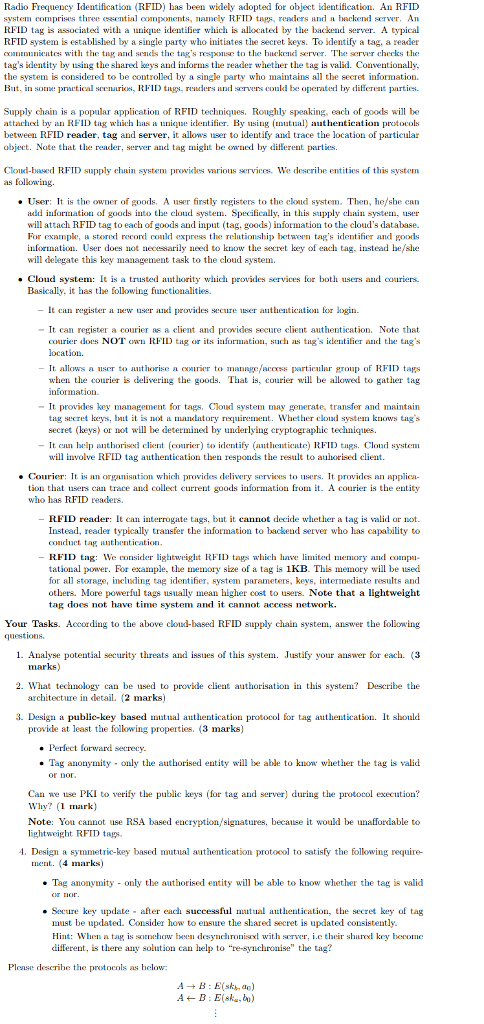
Radio Frequency Identification (RFID) bas been widely adopted for object identification. An RFID system comprises three esential oponents, namcly RFID tags, readers and a backend server. An RFID tag is associated with a uidentifier which is allocated by the backend server. A typical RFID system is established by a single party who initiates the secret keys. To identify a tag, a reader CX31Em11lentes with the tilg and siylds the tngs Tsponse to the hilckrnd server. The server checks the tag's identity by using the shared keys and infors the reader whether the tag is valid. Conventionally the system is considered to be controlled by a single party who maintains all the secret information. But, in sme practical scenaros, RFID tags, rders and servers coudbe operated by difcrent parties. Supply chain is a popular application of RFID techniues. Roughly speaking, each of goods will be attached by an RFID tag which has a unique identifier. By using (mutnal) authentication protocols between RFID reader, tag and server, it allows user to identify and trace the location of particular object. Note that the reader, server and tag might be oaned by different parties. Clonnd-based RFID supply chain system prowides various serviees. We describe entities of this system as following . User: It is the owner of goods. A user firstly registers to the eloud system. Ten, he/she can add information of goods into the cloud system. Specifically, in this supply chain system, user will attach RFID tag to each of goods and input (tag. goods) information to the cloud's database. For example, l. stored recor could express the, relationship between tas identifier and goods information. User does not necessarily need to know the secret key of each tg, instead be/she will delegate this key management task to the cloud system. . Cloud system: It is a trusted authority which provides services for both users and couriers. Basically, it has the following functionalities. - It can register a new user and provides secure user authentication for login. -It can register a courier as a client and prowides secure client authentication Note that courier does NOT oa RFID tag or its informatiot, such as tag's identifier and the tag's location It allows a user to anthorise a orier to mageacss particular oup of RFID tags when the courier is delivering the goods. That is, courier will be allowed to gather tag information It provides key management for tags. Clod system may generate, transfer and maintain tag secret keys, bt it is not a mandatory requirement. Whether cloud system knows tags secret (keys) or not will be deti by underlying cryptographic techniques. - It can help anthorised client (courier) to identify (authenticate) RFID tags. Clond system will involve RFID tag authentication then responds the result to auhorised client. Courier It is an organisation which provides delivery services to users. It povides an applica- tion that users can trace and collect current goods informationfrt. A courier is the entity who has RFID readers. - RFID reader: It can interrogate tags, but it cannot decide whether a tag is valid ornot. Instead, reader typically transfer the information to backend server who has capability to conduct tag anthentication RFID tag: We consider lightweight RFID tags which have limited memory and cop- tational power. For example, the memory size of a tag is 1KB. This memory wil be used for all storage, including tag identifier, system parameters, keys, intermediate results and others. More powerful tags usually mean higher cost to users. Note that a lightweight tag does not have time system and it cannot access network. Your Tasks. According to the abov cloud-based RFID supply chain system, answer the following 1. Analyse potential security threats and issues of this system Justify your answer for each. (3 2. What technology can be used to provide client authorisation in this system? Describe the 3. Design a public-key based mutual authentication protocol for tag authentication. It should architecture in detail. (2 marks) provide at least the following properties. (3 marks) . Perfect forward secrecy. . Tag anonymity only the authorised entity will be able to kon whether the tag is valid Can we use PKI to verily te public keys (for tag and server) during the protocol execution? Note: You cannot use RSA based encryption/signatures, because it would be unaffordable to 4. Design a symmetric-key based mutual authentication protoool to satisfy the following require- . Tag anonymity only the authorised etywll be able to know whether the tag is valid . Secure key update after each successful tual authentication, the secret key of tag Hint: When a tag is soehwbeen desynchronisd with server, i.e their shared key become Why?(1 mark) lightweight RFID taps ment. (4 marks) nmust be updated. Consider how to ensure the shared secret is updated consistently. different, is there any solution can help to "re-synchronise" the tag? Please descrihe the protocols as helow Radio Frequency Identification (RFID) bas been widely adopted for object identification. An RFID system comprises three esential oponents, namcly RFID tags, readers and a backend server. An RFID tag is associated with a uidentifier which is allocated by the backend server. A typical RFID system is established by a single party who initiates the secret keys. To identify a tag, a reader CX31Em11lentes with the tilg and siylds the tngs Tsponse to the hilckrnd server. The server checks the tag's identity by using the shared keys and infors the reader whether the tag is valid. Conventionally the system is considered to be controlled by a single party who maintains all the secret information. But, in sme practical scenaros, RFID tags, rders and servers coudbe operated by difcrent parties. Supply chain is a popular application of RFID techniues. Roughly speaking, each of goods will be attached by an RFID tag which has a unique identifier. By using (mutnal) authentication protocols between RFID reader, tag and server, it allows user to identify and trace the location of particular object. Note that the reader, server and tag might be oaned by different parties. Clonnd-based RFID supply chain system prowides various serviees. We describe entities of this system as following . User: It is the owner of goods. A user firstly registers to the eloud system. Ten, he/she can add information of goods into the cloud system. Specifically, in this supply chain system, user will attach RFID tag to each of goods and input (tag. goods) information to the cloud's database. For example, l. stored recor could express the, relationship between tas identifier and goods information. User does not necessarily need to know the secret key of each tg, instead be/she will delegate this key management task to the cloud system. . Cloud system: It is a trusted authority which provides services for both users and couriers. Basically, it has the following functionalities. - It can register a new user and provides secure user authentication for login. -It can register a courier as a client and prowides secure client authentication Note that courier does NOT oa RFID tag or its informatiot, such as tag's identifier and the tag's location It allows a user to anthorise a orier to mageacss particular oup of RFID tags when the courier is delivering the goods. That is, courier will be allowed to gather tag information It provides key management for tags. Clod system may generate, transfer and maintain tag secret keys, bt it is not a mandatory requirement. Whether cloud system knows tags secret (keys) or not will be deti by underlying cryptographic techniques. - It can help anthorised client (courier) to identify (authenticate) RFID tags. Clond system will involve RFID tag authentication then responds the result to auhorised client. Courier It is an organisation which provides delivery services to users. It povides an applica- tion that users can trace and collect current goods informationfrt. A courier is the entity who has RFID readers. - RFID reader: It can interrogate tags, but it cannot decide whether a tag is valid ornot. Instead, reader typically transfer the information to backend server who has capability to conduct tag anthentication RFID tag: We consider lightweight RFID tags which have limited memory and cop- tational power. For example, the memory size of a tag is 1KB. This memory wil be used for all storage, including tag identifier, system parameters, keys, intermediate results and others. More powerful tags usually mean higher cost to users. Note that a lightweight tag does not have time system and it cannot access network. Your Tasks. According to the abov cloud-based RFID supply chain system, answer the following 1. Analyse potential security threats and issues of this system Justify your answer for each. (3 2. What technology can be used to provide client authorisation in this system? Describe the 3. Design a public-key based mutual authentication protocol for tag authentication. It should architecture in detail. (2 marks) provide at least the following properties. (3 marks) . Perfect forward secrecy. . Tag anonymity only the authorised entity will be able to kon whether the tag is valid Can we use PKI to verily te public keys (for tag and server) during the protocol execution? Note: You cannot use RSA based encryption/signatures, because it would be unaffordable to 4. Design a symmetric-key based mutual authentication protoool to satisfy the following require- . Tag anonymity only the authorised etywll be able to know whether the tag is valid . Secure key update after each successful tual authentication, the secret key of tag Hint: When a tag is soehwbeen desynchronisd with server, i.e their shared key become Why?(1 mark) lightweight RFID taps ment. (4 marks) nmust be updated. Consider how to ensure the shared secret is updated consistently. different, is there any solution can help to "re-synchronise" the tag? Please descrihe the protocols as helow







